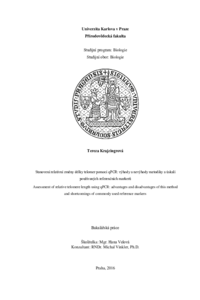Stanovení relativní změny délky telomer pomocí qPCR: výhody a nevýhody metodiky a úskalí používaných referenčních markerů
Assessment of relative telomere length using qPCR: advantages and disadvantages of this method and shortcomings of commonly used reference markers
bachelor thesis (DEFENDED)

View/
Permanent link
http://hdl.handle.net/20.500.11956/75165Identifiers
Study Information System: 171604
CU Caralogue: 990021046830106986
Collections
- Kvalifikační práce [20871]
Author
Advisor
Consultant
Vinkler, Michal
Referee
Králová, Tereza
Faculty / Institute
Faculty of Science
Discipline
Biology
Department
Department of Zoology
Date of defense
8. 9. 2016
Publisher
Univerzita Karlova, Přírodovědecká fakultaLanguage
Czech
Grade
Excellent
Keywords (Czech)
Stárnutí, zkracování telomer, referenční marker, jednokopiový gen, kvantitativní PCR, qPCR, analýza počtu kopií genuKeywords (English)
Senescence, telomere shortening, reference marker, single-copy gene, quantitative PCR, qPCR, gene copy number variation analysisTelomery, sestávající se z repetitivních sekvencí, chrání konce eukaryotických chromozomů před erozí. V běžných somatických buňkách se telomery zkracují s každým buněčným dělením. Délka telomer přímo odpovídá stárnutí na buněčné úrovni. Rychlost zkracování telomer, a tím rychlost stárnutí organismu, je individuální. Liší se nejen mezi druhy, ale i mezi jedinci, a může být ovlivněna mnoha faktory jako je stres, nemoci, reprodukce, či vliv vnějších podmínek. Ke stanovení délky telomer můžeme použít různé metody a každá z nich má své limitace, které je dobré znát a vyhnout se jejich negativnímu dopadu na získané výsledky. V současnosti patří mezi nejpoužívanější metody kvantitativní PCR (qPCR). Mezi nejdůležitější faktory, které mohou ovlivnit výsledky měření délky telomer pomocí qPCR, je množství vmezeřených (tzv. intersticiálních) telomerických sekvencí, správný výběr referenčního markeru, či následné navržení vysoce specifických primerů. I přesto je qPCR vhodná především pro poměrně rychlé a levné stanovení relativní délky telomer u velkého množství vzorků nemodelových organismů. V práci se věnuji i konkrétním výsledkům studií zabývajících se změnou délky telomer u ptáků a možným příčinám, které dynamiku v délce telomer ovlivňují a to z důvodu, že metoda qPCR je právě ve studiích prováděných na ptácích...
Telomeres, the ends of eucaryotic chromosomes, consist of tandem repeated sequences, play important role in protection of chromosomal ends. In somatic cells telomeres are getting shorter with each cell division. Telomere length (TL) is directly related to cellular ageing (senescence). The rate of telomere shortening as well as ageing is individual and it differs among species and also among individuals. To the main factors, which can affect the rate of telomere shortening, belong stress, diseases, reproduction or also environmental conditions. Many methods could be used for TL determination. Each of them has its own limitation, which is good to know to be able to avoid the negative impacts on results. qPCR is currently the most used method. The most important factor, which could affect the results, is that qPCR measures besides proper telomeres also interstitial telomeric sequences. Furthermore, the choice of suitable reference marker followed by designing of highly specific primers is also crucial, if qPCR is used. Nevertheless, qPCR is suitable method especially because it offers fast and inexpensive relative TL measurement of large amount samples. My bachelor thesis is moreover a review of studies focused on telomere dynamics in birds and causes which influence different senescence measured by TL....
